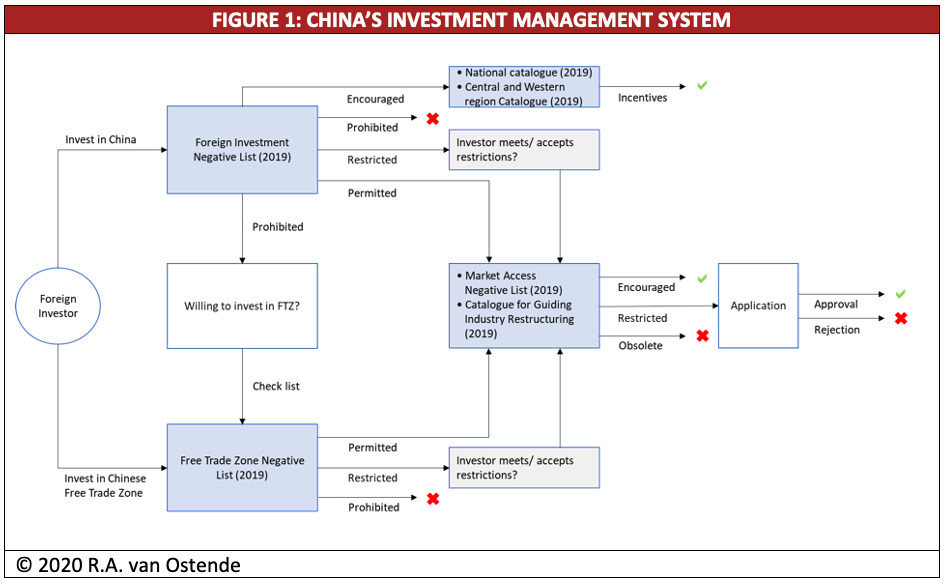 INTRODUCTION
INTRODUCTION
In recent years China has evaluated its existing foreign investment policies and developed and implemented a structured rule-based investment management system. The new Foreign Investment Law which came into effect per 1 January 2020, which combined with its detailed implementation regulations forms the basic law for foreign investment into China.
To manage the inflow and structuring of foreign investments, China operates multiple foreign Investment Negative Lists and Encouraged Lists, which are applicable to foreign investors with an interest to establish an enterprise located in either China or designated national level Pilot Free Trade Zones. In addition, a Market Access Negative List and a Catalogue for Guiding Industry Restructuring is operated, applicable to both foreign and domestic investors.
In this article China’s foreign investment management system is introduced to provide foreign investors with a detailed understanding on how the process of investment into China is structured. The steps to be taken by the foreign investor to determine whether the desired investments are possible and which requirements and conditions might apply is discussed in detail.

APPLICABLE FOREIGN INVESTMENT-CENTERED REGULATIONS
Per 1 January 2020 China’s new Foreign Investment Law entered into effect, replacing the 1979 Law on Sino-Foreign Equity Joint Ventures, the 1986 Law on Wholly-Foreign-Owned Enterprises and the 1988 Law on Sino-Foreign Contractual Joint Ventures. The Foreign Investment Law combined with its detailed implementation regulations forms the basic law for foreign investment into China. Article 4 of the law stipulates that the State shall implement management systems of pre-establishment national treatment and negative list for foreign investment.
Foreign Investment Negative Lists
In addition to the Foreign Investment Law, China operates an investment catalogue system that combines elements of both open and closed lists. The Catalogues for Guidance of Foreign Investment Projects categorizes foreign investment based on industry and subdivides it into three categories, namely “prohibited”, “restricted” and “permitted”.
- The prohibited catalogue is effectively a negative list detailing sectors in which foreign investment is not permitted, neither through direct investment, partnerships or takeovers.
- The restricted catalogue contains an overview of sectors and activities in which foreign investment is permitted, but in which the project examination and approval process may be stricter and take longer. Conditions to the investment might apply and are specified in the catalogue.
- The permitted catalogue is not published. This means that foreign investors can establish enterprises and enter the Chinese market on an equal footing with domestic enterprises.
Foreign investors looking to enter the Chinese market may first review the foreign investment catalogue applicable to the territory of mainland China. In the event desired business activities are not permitted to be undertaken, or restrictions apply, foreign investors may review the foreign investment catalogue applicable to China’s Pilot Free Trade Zones to determine foreign investment is permitted or whether similar restrictions apply.
Effectively, China operates two catalogue systems in parallel; one catalogue system applies to the overall mainland China region on a national level and the second catalogue system is applicable to the designated national level Pilot Free Trade Zones. The content of the two catalogue systems differs as there are fewer regulatory restrictions in Pilot Free Trade Zones in selected cities compared to the mainland China region.
Foreign Investment Encouraged Lists
In addition to the negative lists, an encouraged catalogue exists which provides an overview of industries where foreign investment is welcomed, and where investors may be able to enjoy preferential treatment from respective local governments. The foreign investment encouraged catalogue is divided into two sub-catalogues; one catalogue applies to the whole country and the other catalogue is applicable to 22 provinces located in China’s central, western, and northeastern regions.
APPLICABLE DOMESTIC AND FOREIGN INVESTMENT-CENTERED REGULATIONS
When the desired investment is allowed, or restrictions apply which are deemed acceptable by the investor, next step is to review the Market Access Negative List to understand whether licensing or certification requirements apply. In parallel the investor is to review the Catalogue for Guiding Industry Restructuring to understand whether specific technology, equipment, and products are allowed to be utilized in China.
Market Access Negative List
China’s Market Access Negative List applies to both domestic and foreign investors. Similar to The Catalogues for Guidance of Foreign Investment Projects, investments are categorized based on industry and subdivided into three categories, namely “prohibited”, “restricted”, “permitted”. The “permitted” catalogue is not published. The negative list provides an overview of relevant procedures, technical standards and qualification criteria to enter restricted markets as well as the respective government departments in charge of each industry and further outlines prohibitive regulations.
Catalogue for Guiding Industry Restructuring
China's industrial policy is reflected in the "Catalog for Industry Restructuring". The catalog is an important guide for investment directions as it provides insight in how the Chinese authorities manage investment projects, formulate and implements fiscal, tax, credit, land, import and export policies. The Catalogue subdivides industries into “encouraged”, “restricted” and “obsolete” categories. Business activities in industries that are not categorized as “encouraged”, “restricted” or “obsolete”, and comply with the relevant national laws, regulations and policies, are allowed to be performed. Permissible categories are not included in the "Catalog for Industry Restructuring".
- The encouraged category consists mainly out of industries that utilize key technologies, equipment and products that have an important role in promoting economic and social development, contribute to saving resources, protection of the environment, and optimizing and upgrading the industrial structure. The industries are encouraged and supported by policies and measures.
- The restricted category consists out of industries that mainly utilize backward technology which do not meet industry access conditions and relevant regulations, which do not contribute to the optimization and upgrading of China’s industrial structure. These industries are supervised by the Chinese authorities. Focus goes out to transformation of these industries and prohibition of new production capacity, process technology, equipment and products.
- The elimination categories consists out of industries that utilize mainly backward technologies, equipment and products that do not comply with relevant laws and regulations, seriously waste resources, pollute the environment, and do not have the conditions for safe production.
CONCLUSION
China has established a structured rule-based investment management system to manage foreign direct investment inflows. As the new Foreign Investment Law and its detailed implementation regulations came only into effect per 1 January 2020, it is expected that more rules and regulations will be issued in the near future to provide more clarity and guidance on the new foreign investment management system.
Understanding and navigating China’s foreign investment landscape is complex. Foreign investment requires well-informed decision-making as it reflects a long-term commitment of the investor. Support of an expert in the subject matter is highly recommended.
AUTHOR
 Professor Dr. van Ostende is a regional expert for China investment and trade with many publications to his credit. He presently lives and works in China. His areas of interest revolve around International Business in emerging Asian markets, with a focus on the fields of Foreign Direct Investment, Foreign Market Entry and Strategic Decision Making. Dr. van Ostende has held multiple senior financial management positions of foreign invested companies of European origin with Asian headquarters located in China. Responsibilities include Corporate Finance, Controlling, Administration, Human Resources & Recruitment, IT and Legal. From these support functions Dr. Van Ostende has been continuously contributing towards corporate (re)structuring, ensuring compliance and data-driven enhancement of efficiency and effectivity in business processes. He has been a Guest Professor at Nanjing Normal University in China as well as a course developer and lecturer at NTI University of Applied Sciences in the Netherlands. Dr. Van Ostende’s expertise in the field of Foreign Investment into China has been widely acknowledged. He is named Honorary Ambassador for Investment Promotion of Nanjing Gulou District Government and Honorary Strategic Partner for Investment promotion of Nanjing Jianye District Government. Professor van Ostende is a recipient of China’s Jiangsu Province Youth Friendship Award.
Professor Dr. van Ostende is a regional expert for China investment and trade with many publications to his credit. He presently lives and works in China. His areas of interest revolve around International Business in emerging Asian markets, with a focus on the fields of Foreign Direct Investment, Foreign Market Entry and Strategic Decision Making. Dr. van Ostende has held multiple senior financial management positions of foreign invested companies of European origin with Asian headquarters located in China. Responsibilities include Corporate Finance, Controlling, Administration, Human Resources & Recruitment, IT and Legal. From these support functions Dr. Van Ostende has been continuously contributing towards corporate (re)structuring, ensuring compliance and data-driven enhancement of efficiency and effectivity in business processes. He has been a Guest Professor at Nanjing Normal University in China as well as a course developer and lecturer at NTI University of Applied Sciences in the Netherlands. Dr. Van Ostende’s expertise in the field of Foreign Investment into China has been widely acknowledged. He is named Honorary Ambassador for Investment Promotion of Nanjing Gulou District Government and Honorary Strategic Partner for Investment promotion of Nanjing Jianye District Government. Professor van Ostende is a recipient of China’s Jiangsu Province Youth Friendship Award.
SOURCES
- Ministry of Commerce. (2019). Special management measures for foreign investment access
(Negative list) (2019 edition) “FI Negative List”. - National Development and Reform Commission and Ministry of Commerce. (2019). Special Administrative Measures for Foreign Investment Access in the Pilot Free Trade Zone (Negative list) (2019 edition) “FTZ FI Negative List”.
- National Development and Reform Commission and Ministry of Commerce. (2019). Negative List of Market Access (2019 Edition).
- National Development and Reform Commission and Ministry of Commerce. (2019). Directory of encouraged foreign investment industries (2019 edition).
- National Development and Reform Commission and Ministry of Commerce. (2019). Catalogue for Guiding Industry Restructuring (2019 version).
- State Council. (2019). Foreign Investment Law of the People’s Republic of China (Adopted at the Second Session of the 13th National People’s Congress on March 15, 2019).
- State Council. (2019). Implementation Regulations of the Foreign Investment Law of the People’s Republic of China.

